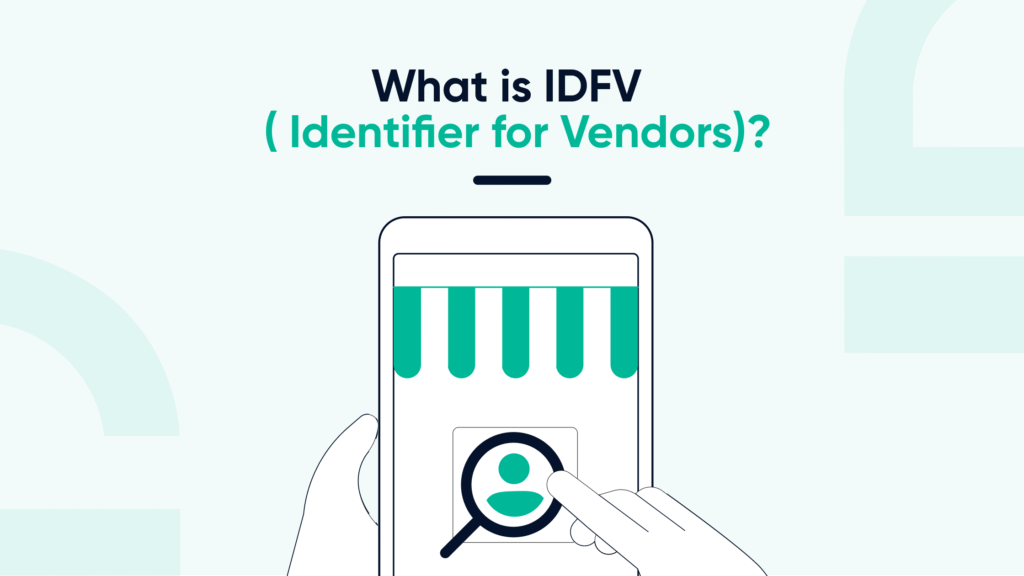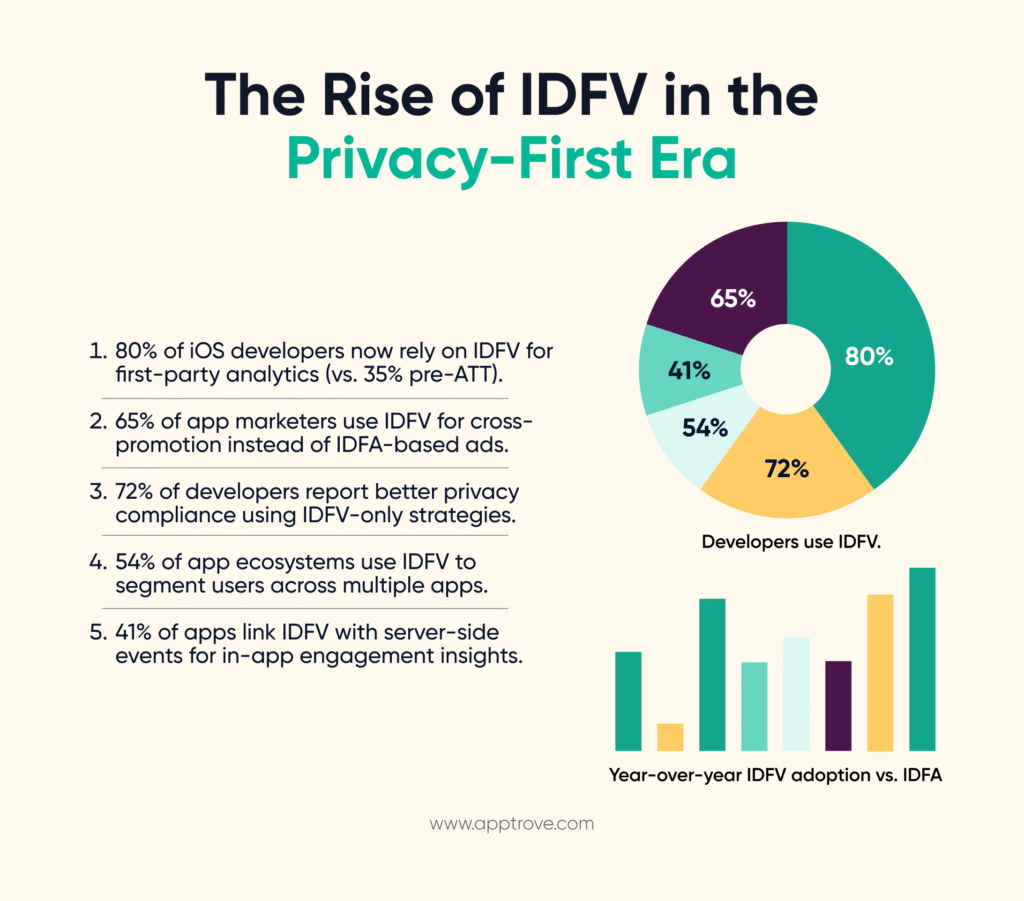Identifier for Vendors (IDFV)

The Identifier for Vendors (IDFV) is a distinct alphanumeric code assigned by Apple to all apps from the same developer on a single device. This allows developers to assess user behaviour, examine engagement, and execute cross-promotion initiatives within their own app ecosystem while not providing any personally identifiable information (PII).
An IDFV will generally look like a 32-character string separated by dashes into five groups (for example):
F325G3GB-12FC-352F-C6C3-DZ52F0F690D8
Purpose and Use
The IDFV enables developers to obtain knowledge regarding how users engage with their suite of applications on a single device. This provides developers the ability to:
- Explain User Engagement and Behaviour Patterns Across Apps
- Undertake Cross Promotion Strategies to Induce Users to Install Other Apps in Their Ecosystem
- Carry Out Frequency Capping, Directing Users to Only View a Certain Advertisement a Limited Number of Times, When Users View Other Marketing in Their Ecosystem
- Develop First-Party Data Sets that Increase Personalization and Retention Without Violating Apple’s Privacy Restrictions.
Because the IDFV is deemed anonymized first-party data, it can be used unless created with third-party data sources without the requirement of consent.
How It Works
Upon installation of an app, Apple assigns an “Identifier for Vendors” value specifically to all apps created by that developer on that device, even if they are not all installed at the time. Any apps by the vendor that are installed, share the same IDFV. If the user uninstalls all apps by that vendor, the identifier becomes purged as well. If the user installs an app from that vendor again, the IDFV value will be created again.
This functionality ensures that IDFV data will only be allowed within that vendor’s ecosystem and will not provide information on users across apps from various developers, or multiple devices. It is essentially acting like a first-party cookie in the mobile app space, allowing developers to see user behavior while complying with Apple’s privacy policies.
Comparison: IDFV vs. IDFA

| Feature | IDFV | IDFA |
| Scope | Shared across apps from the same developer on one device | Shared across all apps and developers on a device |
| Purpose | First-party analytics, cross-promotion, frequency capping | Advertising attribution and cross-app user tracking |
| Consent Requirement | Does not require user consent under ATT (if not combined with third-party data) | Requires explicit user opt-in under App Tracking Transparency |
| Reset Mechanism | Automatically reset when all apps from a developer are deleted | Can be manually reset by the user at any time |
| Attribution | Not suitable for third-party attribution | Used for advertising attribution and campaign tracking |
Importance in the Privacy-First Ecosystem

Apple’s privacy policies have profoundly transformed the mobile advertising landscape. The IDFA limitation has motivated developers to embrace first-party data strategies, and IDFV plays a central role.
Using this allows vendors to:
- Maintain analytics rigor without sacrificing user privacy.
- Enhance ad relevance and user experiences within their applications.
- Support product development by revealing patterns within cross app engagement.
- Provide internal attribution for cross-promote and reinstall measurement.
Since the IDFV cannot be used to identify users across independent ecosystems, it effectively protects both user privacy and business intelligence.
Technical Characteristics
- Format: 32-alpha-numeric code (T563P9YS-856G-473X-H1J2-FC94L0T37IC6).
- Assignment: Automatically generated by Apple, per developer, per device.
- Persistence: Lingers until all applications associated with the vendor are removed
- Scope: Shared across all apps installed on one device, from the same vendor.
- Anonymity: Does not expose PII and can’t be linked across vendors or devices.
Benefits for Developers
The IDFV presents various benefits for developers who manage multiple apps in the same ecosystem:
- Cross-App Insights: This enables a global view of user engagement across the developer’s portfolio of apps.
- First-Party Data Collection: It helps with internal analytics and audience segmentation, built on first-party data.
- Advertising Efficiency: This helps improve ad targeting and frequency capping based on analytics and engagement within the ecosystem.
- Privacy Compliant: It is used within Apple’s framework, as long as it is not paired with 3rd party data.
- Reinstall Tracking: It also helps identify users who return without the use of IDFA or fingerprinting methods.
For a rare platform like Apptrove, IDFV is a trusted structure for building privacy-safe user analytics and cross-promotion strategies that comply with Apple’s approach.
Limitations
Although the IDFV has several advantages, it has limitations.
- Limited Scope: Works only across apps from the same vendor and cannot be sent outside.
- No Cross-Device Tracking: IDFV is tied to that device; usage data for a user can’t be tied to another device.
- Dependent on App Presence: If the user uninstalls every app by that vendor, then the identifier is removed.
- No Attribution Support: IDFV can’t replace IDFA for campaign-based attribution across ad networks.
Consequently, It is better suited for use cases such as first-party measurement, audience analysis, and boosting engagement rather than third-party advertising attribution.
Key Takeaways
The Identifier for Vendors (IDFV) is an identifier, per vendor, linked to the device in a privacy-compliant first-party context, which enables developers to measure their users’ engagement across their apps.
It is critical for doing cross-promotion, frequency capping, and providing internal attribution in post-ATT conditions where access to IDFA is limited. This is part of the industry-wide movement of first-party data ownership, allowing developers to understand the behaviours of their customers without biometric identifiers.
IDFV data is present in the vendor’s ecosystem and is automatically refreshed if all apps from that vendor are deleted.
Conclusion
IDFV is a secure, privacy-sensitive option for app developers to operate in today’s increasingly restrictive, data-prohibitive ad landscape. Platforms like Apptrove use IDFV as a part of a well-designed, integrated first-party measurement protocol, supporting developers in continuing to hold on to insight, efficiency, and compliance in an ad ecosystem where users increasingly prioritize privacy and protection of their data.
from Apptrove https://apptrove.com/what-is-idfv-apptrove/
via Apptrove
Comments
Post a Comment